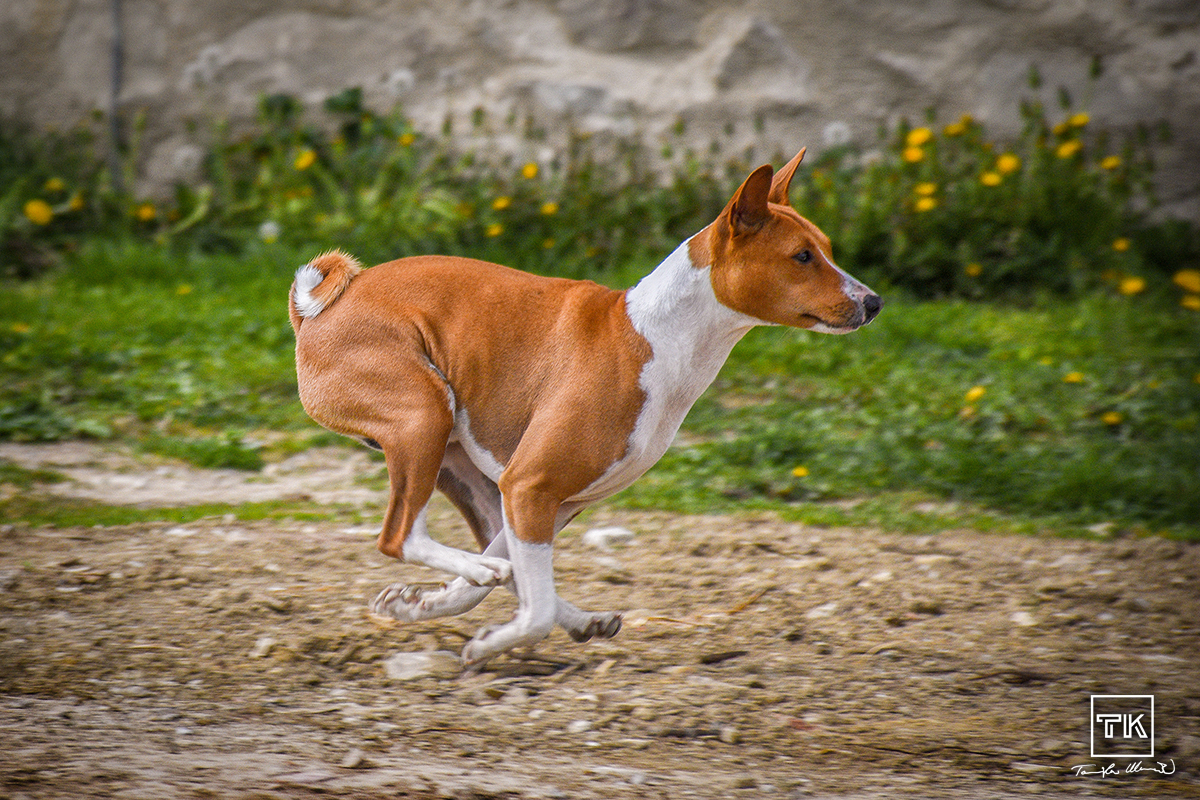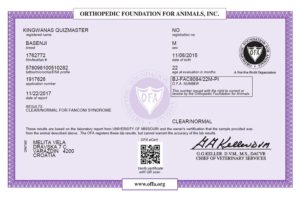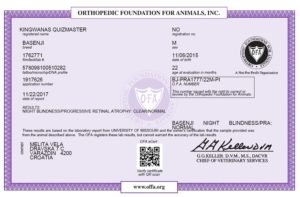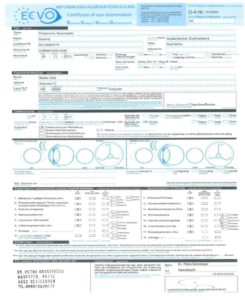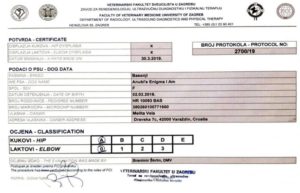If you’re buying a puppy, find a good breeder who will show your health clearances for both your puppy’s parents. Health clearances prove that a dog has been tested for and cleared of a particular condition. In Basenjis, you should expect to see health clearances for FANCONI and PRA, PPM and hip dysplasia/elbow dysplasia and hypothyroidism from country where the kennel is from. Sometimes the father (stud Dog) doesn’t have all of these tests because each country end kennel club has its own rules. But tests for FANCONI and PRA must be presented without excuse. It is recommended to confirm health clearance on the OFFA web site database (offa.org).
Genetic Predispositions for Basenjis
Kidney Disorder
Fanconi syndrome is a disorder of the kidneys that allows vital blood nutrients to escape into the urine. Because these nutrients are so important, affected Basenjis can experience excessive urination and thirst, weight loss, and weakness due to abnormal electrolyte levels. Symptoms usually appear between two and six years of age. The severity and course of the disease varies from dog to dog; some pets remain stable for years while others may develop fatal kidney failure. Routine urine screening can help to diagnose Fanconi syndrome in its early stages, and prompt treatment can greatly extend both your pet’s lifespan and his quality of life.
You will get one of the following results:
Fanconi Syndrome CLEAR
Fanconi Syndrome CARRIER
Fanconi Syndrome AFFECTED
Fanconi: combination clear + carrier of parents is very often in our breeding program. At least one of the parent dogs must be tested “clear”. Affected individuals should not be used in breeding. Also breeding carrier + carrier is not allowed.
Genetic test for FANCONI SYNDROM
Visit www.offa.org to check results or order your own test.
Eye Problems
Progressive Retinal Atrophy(PRA)
Progressive retinal atrophy (PRA) is an inherited disease in which the eyes are genetically programmed to go blind. Unfortunately, Basenjis are a bit more likely than other dogs to have this condition. PRA is not painful, but also not curable. In dogs with this gene, early symptoms such as night blindness or dilated pupils generally begin around three to five years of age. A genetic test is available for this condition.
You will get one of the following results:
Progressive Retinal Atrophy(PRA) CLEAR
Progressive Retinal Atrophy(PRA) CARRIER
Progressive Retinal Atrophy(PRA) AFFECTED
(PR): Combination clear + carrier of parents is very often in our breeding program. At least one of the parent dogs must be tested “clear”. Affected individuals should not be used in breeding. Also breeding carrier + carrier is not allowed.
Genetic test for PRA
Visit www.offa.org to check results or order your own test.
Persistent Pupillary Membrane (PPM)
When the puppy is born, his eyes have a bluish color. This color is derived from embryotic membranes covering the eyes. As the puppy grows, these membranes will break down, and they will normally completely disappear when the puppy is 4- 5 weeks old. But sometimes they persist. When these membranes do not disappear, we call it PPM. The strands can stretch from iris to iris, iris to lens, or cornea to iris, and sometimes they are found in the anterior (front) chamber of the eye. For many dogs, the strands do not cause any problems and generally they break down by 8 weeks of age. If the strands do not break down, they can lead to cataracts or cause corneal opacities. Eye drops prescribed by your veterinarian can help break them down.
• IRIS TO IRIS Sometimes small strands of tissue meant to disappear soon after birth remain attached to the iris. This condition is called persistent pupillary membrane, and your Basenji is more likely to have this condition than other dogs. Fortunately, these tissue bits usually don’t hurt or impede vision.
• IRIS TO LENS These vascular strands come from the iris and go through the pupil space to attach to the lens of the eye, located behind the iris tissue. These strands attach the iris at one end and the lens of the eye at the other end, causing a minor cataract (a clouding of the lens of the eye) which will, in turn, cause a minor vision problem in your dog
• IRIS TO CORNEA Corneal dystrophy is an inherited condition in Basenjis that causes small, white crystal deposits to form in one of the layers of the cornea, the clear outer layer at the front of the eye. There is no known effective medical treatment to remove the deposits. Usually the disease progresses slowly, doesn’t hurt, and causes only minor vision obstruction. In severe cases, surgery may be considered for deposit removal, but there is possibility the crystals may return.
• CATARACTS are a common cause of blindness in older Basenjis. We’ll watch for the lenses of his eyes to become more opaque—meaning they look cloudy instead of clear—when we examine him. Many dogs adjust well to losing their vision and get along just fine. Surgery to remove cataracts and restore sight may also be an option. Forbidden for breeding.
Test for PPM
Hip and Elbow Dysplasia
This is a heritable condition in which the thighbone doesn’t fit snugly into the hip joint. Some dogs show pain and lameness on one or both rear legs, but you may not notice any signs of discomfort in a dog with hip dysplasia. As the dog ages, arthritis can develop. Stiffness in your Basenji’s elbows or hips may become a problem for him, especially as he matures. You may notice that he begins to show lameness in his legs or has difficulty getting up from lying down. We can treat the arthritis—the sooner the better—to minimize discomfort and pain. We’ll take X-rays of your dog’s bones to identify issues as early as possible. Surgery is also sometimes a good option in severe and life-limiting cases. And keep in mind that overweight dogs may develop arthritis years earlier than those of normal weight, causing undue pain and suffering!
Dogs with hip dysplasia should not be bred. If you’re buying a puppy, ask the breeder for proof that the parents have been tested for hip dysplasia and are free of problems. Hip dysplasia is hereditary, but it can also be triggered by environmental factors, such as letting a puppy gain too much weight too quickly or injuries incurred from jumping or falling on slick floors. That’s why it’s sometimes diagnosed in puppies whose parents were free of the disease. Hip joint dysplasia (HD): Both breeding animals should be tested with result “free” (A or B) for future breeding program.
Test for HIPS and ELBOWS
Knee Problems
Sometimes your Basenji’s kneecap (patella) may slip out of place. This is called patellar luxation. You might notice that your pet, while running, suddenly picks up a back leg or skips and hops for a few strides. He might then kick his leg out sideways to pop the kneecap back in place. These are common signs of patellar luxation. If the problem is mild and involves only one leg, your friend may not require much treatment beyond arthritis medication. When symptoms are severe, surgery may be needed to realign the kneecap to keep it from luxating further.
Thyroid Problems
Hypothyroidism is caused by a deficiency of thyroid hormone and may produce signs that include infertility, obesity, mental dullness, and lack of energy. The dog’s fur may become coarse and brittle and begin to fall out, while the skin becomes tough and dark. It can be managed very well with a thyroid replacement pill daily. Medication must continue throughout the dog’s life. They should be tested for what is called T4, T3, TSH and TgAA.
Bladder or Kidney Stones
There are a few different types of stones that can form in the kidney or in the bladder, and Basenjis are more likely to develop them than other breeds. We’ll periodically test his urine for telltale signs indicating the presence of kidney and bladder stones, which in addition are very painful! If your buddy has blood in his urine, can’t urinate, or is straining to urinate, it is a medical emergency. Call the Vet immediately!
Cystinuria
This is the most common type of kidney stones in basenji breed.
It is due to a hereditary defect in the kidneys that causes impaired reabsorption of an amino acid called cysteine. This amino acid can form stones if the pH of the urine is low and the urine is concentrated. The condition is most common in male dogs. Bitches can also get cysteine stones but will usually be symptom-free due to tips anatomy (she will usually be able to urinate the stones while in a male dog the stone will get stuck).
Prevention
Basenji should not be fed with high protein (adult dogs should not have a feed with higher than 25% protein content). Dry food should also be soaked to ensure better fluid uptake.
It is observed that the Acana and Orijen types of food can act as trigger for urine stones formation in dogs that are genetically predisposed to Cystinuria.
We have had a growth of cystinuria (urine stone) on basenji in recent years (this is written in 2018). Unfortunately, testing is difficult. Healthy dogs can produce sick offspring, and the way this is inherited is not concluded. Work is currently underway on a DNA test that will make it easier for breeders. We hope it will be ready soon!
Epilepsy
There are three types of seizures in dogs: reactive, secondary, and primary. Reactive seizures are caused by the brain’s reaction to a metabolic problem like low blood sugar, organ failure, or a toxin. Secondary seizures are the result of a brain tumor, stroke, or trauma. If no other cause can be found, the disease is called primary or idiopathic epilepsy. This problem is often an inherited condition, and Basenjis are commonly afflicted. If your friend is prone to seizures, episodes will usually begin between six months and three years of age. An initial diagnostic workup may help find the cause. Lifelong medication is usually necessary to help keep seizures under control with periodic blood testing required to monitor side effects and efficacy. If your dog has a seizure, carefully prevent him from injuring himself.
Umbilical Hernia
Umbilical hernia is a very common in Basenji. UH present at birth where abdominal fat or internal organs protrude against the abdominal wall near the umbilicus. If the hernia is small, it can be left without treatment. Basenjis have often small hernias. They are usually spontaneously being closed as they become adult dog.


